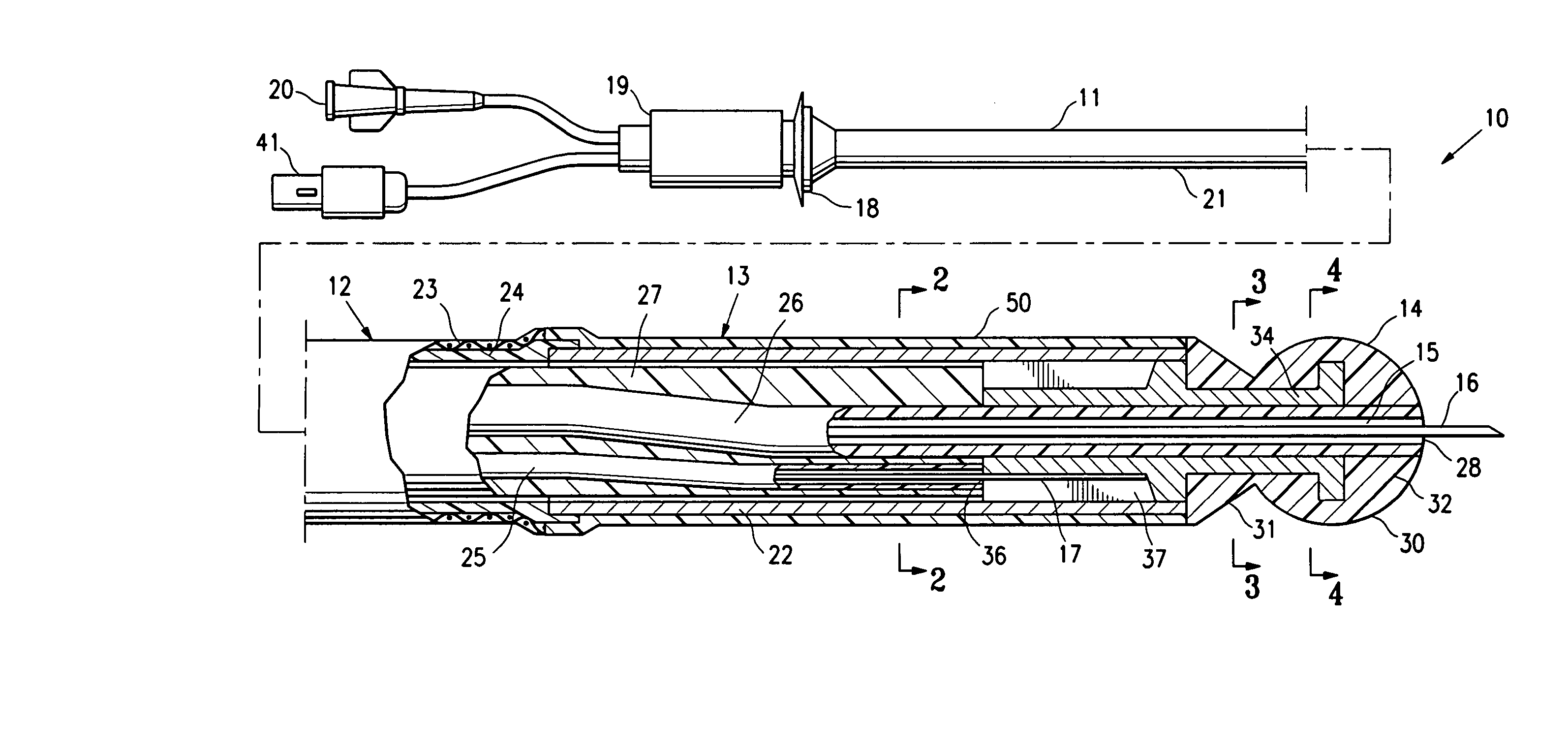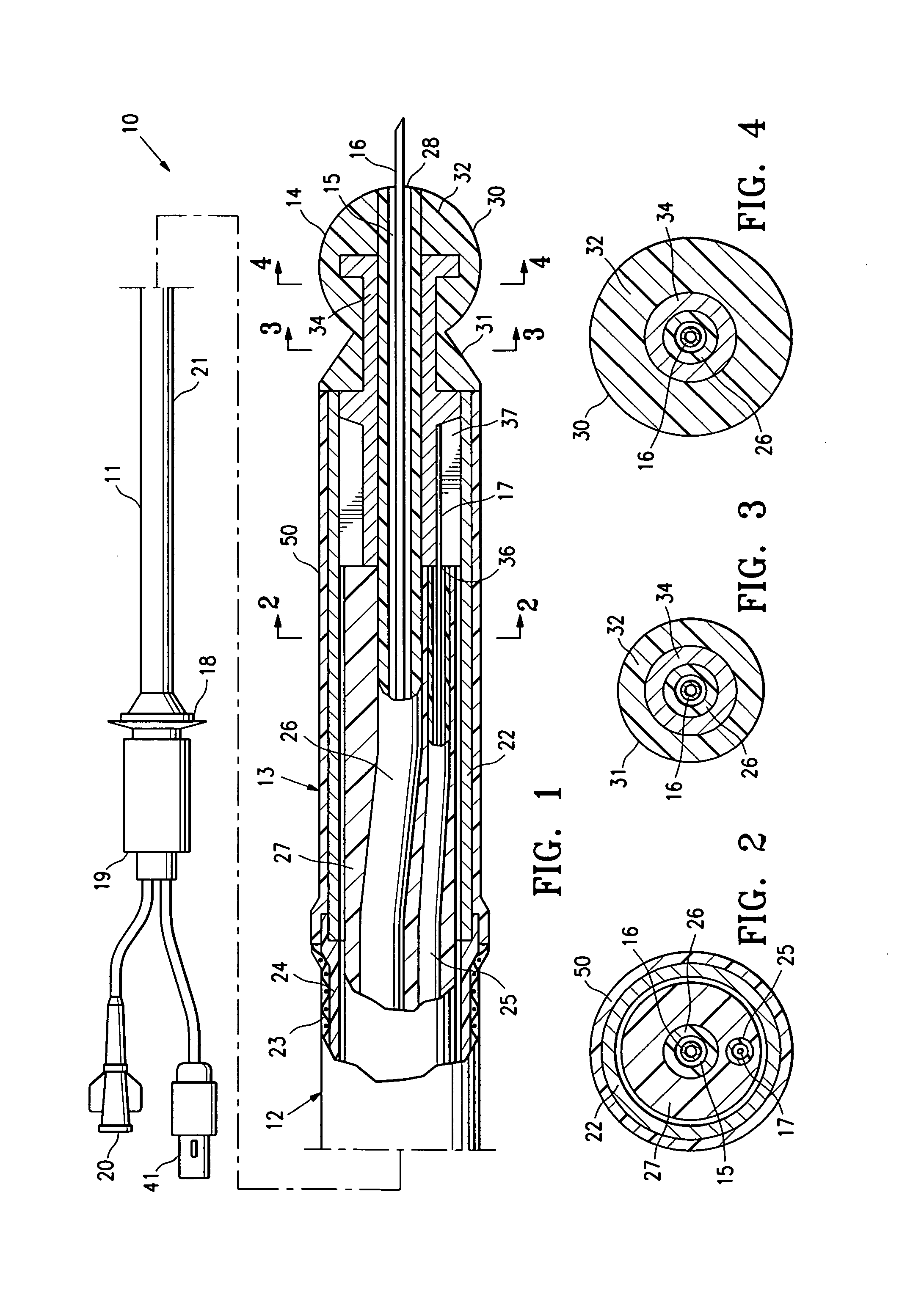[0009] The ICPs readily blend or otherwise combine with the matrix
polymer materials, and preferably possess relatively high thermal oxidative stability (e.g., up to about 300° C.) which facilitates
processing the ICPs into the matrix
polymer material without degradation or loss of
conductivity. Consequently, the ICPs can be melt-processed with a variety of commonly used low-conductive matrix polymers, for ease of manufacturability and without the compounding difficulties of
metal or carbon additives. Compared to conductive
metal-filled systems, the ICPs provide substantial weight savings, flexibility, durability, low-temperature processibility, and tailored reproducible
conductivity. Additionally, due to the improved compatibility with the matrix
polymer, the ICPs preferably have reduced sloughing compared to carbon loaded formulations, and preferably do not disadvantageously affect the
cohesive strength of the matrix polymer.
[0010] The ICP distal tip
electrode facilitates
ultrasonic imaging of the catheter distal end within the patient, compared to a conventional metallic tip
electrode, by reducing the amount of metal in the distal tip. Specifically, metallic material in a conventional catheter distal tip absorbs stores and then reemits the sonic energy of the ultrasonic imaging device, causing the metal in the tip to ring like a bell, sending out ultrasonic energy until the sonic energy that it has stored is depleted. This absorbed, stored and then reemitted sonic energy is received by the ultrasonic imaging device and creates images behind the catheter tip that decrease in brightness and size as the stored sonic energy is depleted, forming the tip
pyramid artifact. On the other hand, polymeric materials produce echoes from their surfaces in the body that are usually of less amplitude than the thick metallic surfaces of conventional
electrode tips. Additionally, polymeric materials are generally more dissipative of sonic energy than
metallic materials and thus, if any
pyramid artifact is produced, it is of smaller amplitude than those produced by tips / electrodes formed completely of metal or of a higher proportion of
metallic materials. A disadvantageously bright / long duration / large tip
pyramid artifact obscures the actual image of the catheter tip and surrounding
anatomy. In contrast, a distal tip of the invention, configured to minimize the amount of metallic material at the distal tip, reduces the amount of sonic energy that the tip stores and then reemits to thereby reduce the brightness and duration of the tip pyramid artifact. The soft polymeric distal tip completely eliminates, or at least reduces, the tip pyramid artifact of prior metallic or metallic / polymer
hybrid electrode catheter tips.
[0012] As discussed above, the polymeric distal tip of the invention prevents or reduces the tip pyramid artifact image. However, in the absence of a direct echo from the tip, the only ultrasonic image of the tip may be that due to the absorbed, stored and then reemitted sonic energy (i.e., the tip pyramid artifact). As a result, in a presently preferred embodiment, the polymeric distal tip has a spherical shape, as set forth in copending, commonly assigned U.S.
patent application Ser. No. 11 / 293,420 ('420 Application”), incorporated by reference herein in its entirety. The spherical distal tip shape is configured to produce direct echoes, from a large
angular range, and thereby prevents or minimizes the potential for misreading the position of the distal tip from the ultrasonic image, by avoiding the absence of an imaged direct echo from the distal tip. As discussed in the '420 Application, the spherical distal tip shape produces diffuse echoes such that the distal tip is directly imaged over a range of angles (relative to the catheter) substantially greater than 180°. Thus, the conductive polymeric distal tip of the invention, provided with a spherical shape, facilitates accurately positioning the catheter distal tip under ultrasonic imaging by providing an imaged direct echo with little or no tip pyramid artifact over a wide range of angles (i.e., with the catheter tip oriented in the patient at a wide variety of angles relative to the ultrasonic imaging device outside of the patient). The imaged direct echo indicates the actual location of the distal tip in the patient, unlike a tip pyramid artifact (if present) which is located behind the actual location of the catheter tip due to the
delay in reemitting the sonic energy in the direction of the imaging device.
[0015] In one embodiment, a method of the invention generally comprises advancing within a patient's
anatomy an echogenic
needle catheter comprising an elongated shaft, a polymeric distal tip which is formed at least in part of an ICP and which has a port at a distal end of the distal tip, and preferably a needle which extends distally from the distal tip port in an extended configuration. The method includes directing sonic energy at the distal tip from an ultrasonic imaging device, to produce an ultrasonic image of the distal tip with eliminated or reduced pyramid artifact compared to a distal tip having a metallic tip electrode, and positioning the distal tip at a desired location within the patient.
[0016] A catheter distal tip of the invention minimizes the amount of metal in the tip and thus reduces its echo amplitudes, and reduces or eliminates its pyramid artifact. The ICP
conductive materials have improved electrical, mechanical and melt-flow properties. Specifically, a catheter distal tip of the invention formed of the ICP has an improved combination of good
cohesive strength, flexibility, and
high conductivity, unlike prior “conductive polymeric” distal tips which required high levels of metallic or
carbon doping to be conductive. Additionally, the ICP conductive blends have greatly reduced compounding difficulties compared with the prior metal- or carbon-doped formulations. These and other advantages of the invention will become more apparent from the following detailed description and exemplary drawings.
 Login to View More
Login to View More 


